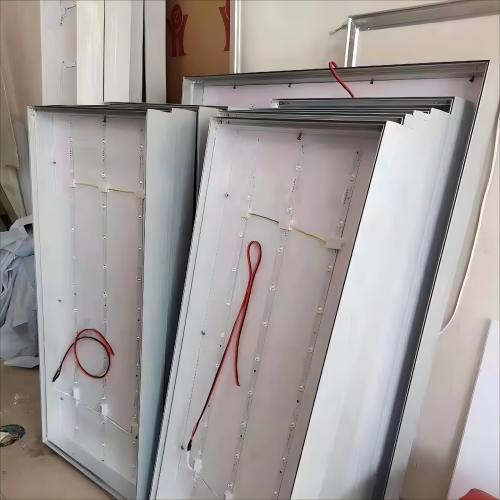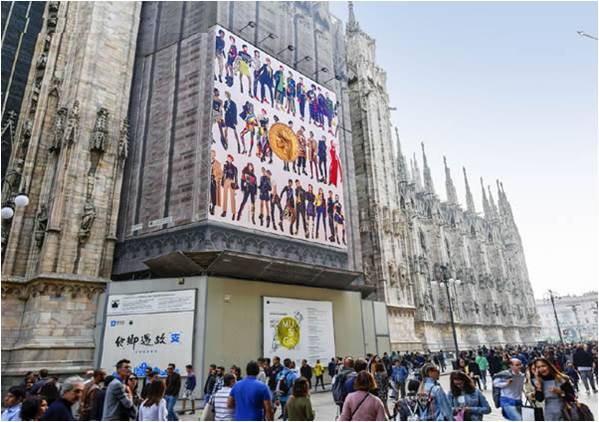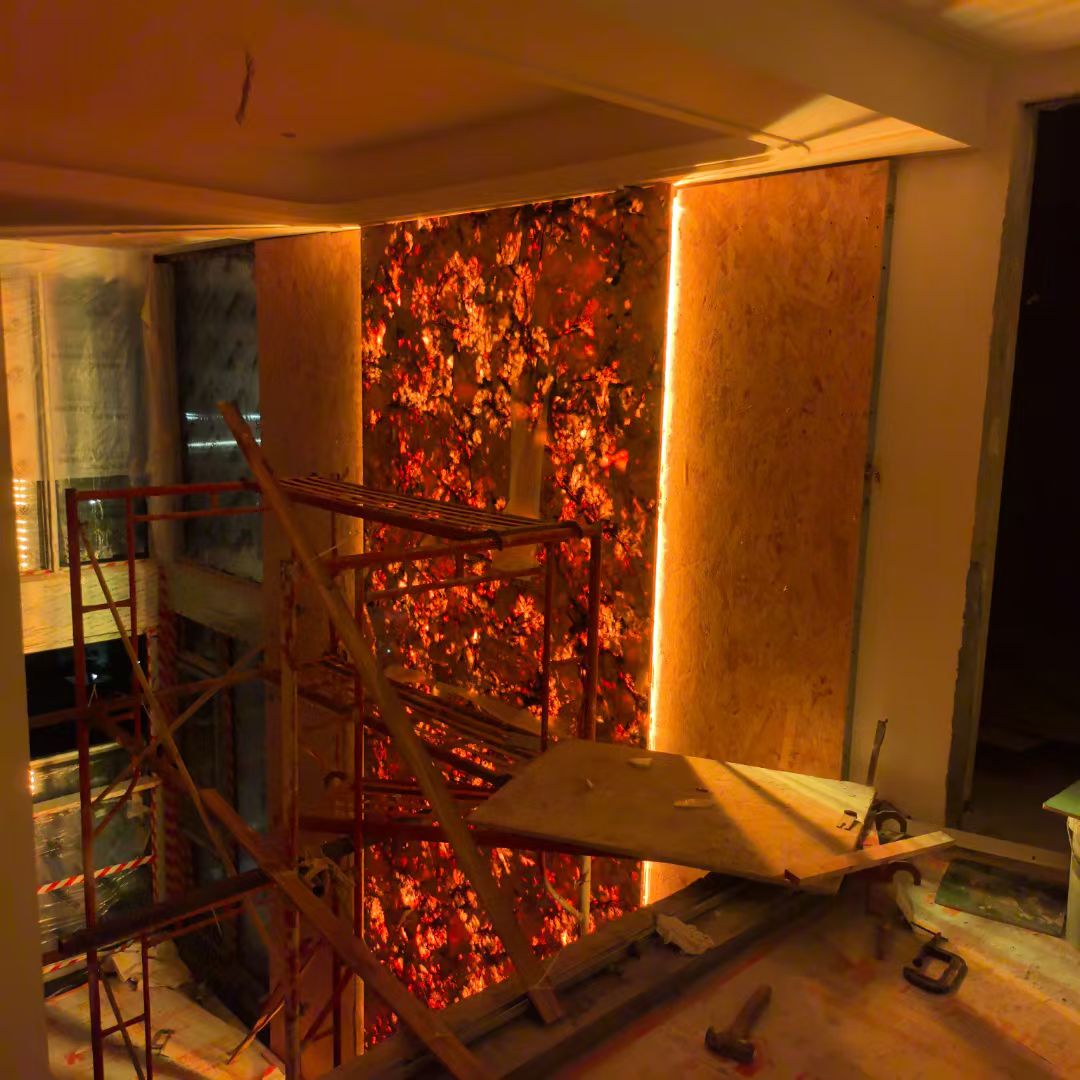How to choose lighting products for illuminated background walls: A comprehensive guide to illuminated background walls solutions
How to choose lighting products for illuminated background walls: A comprehensive guide to illuminated background walls solutions
Introduction: The Magic of Lighting: Allowing the Walls to Serve as a Medium of Communication
A recent study revealed that during home renovations, 80% of homeowners allocate a significant portion of their budget to interior lighting design, while 40% of their spending is directed towards the implementation of "influencer-inspired background walls." The result is frequently breathtaking during daylight hours, but it can be disconcerting at nighttime. The cold white light has the effect of glaring, causing shadows to appear dark, and making the textures of materials appear "eaten up" by the light.
Indeed, the lighting design of a wall is responsible for the majority—approximately 70%—of the luxurious feel of the space. The strategic application of lighting can metamorphose a television wall into a cinematic viewing area, a bedside wall into an immersive healing space, and even metamorphose ordinary stone into a museum-quality finish through the artful use of light and shadow.
This article will elucidate the lighting secrets of luminous background walls from three perspectives: lamp type, technical specifications, and scene compatibility. This guide is intended for individuals with varying degrees of experience in homeownership, ranging from novice to experienced. Indeed, the true atmosphere of a space is not realized through the mere presence of numerous fixtures; rather, it is achieved through the meticulous use of light and shadow to create a precise visual language.
First, common lamp types and core functions.
A: Linear luminaires: The process entails meticulous outlining and systematic washing of walls.
Linear luminaires have been shown to create a cohesive effect on background walls through continuous light strips, making them suitable for large-area lighting and creating dynamic effects.
1. LED Diffuse Reflection Rolling Light Strips
Technical Features: The utilization of surface-mount LEDs, specifically SMD2835 or SMD3030 models, results in the emission of a luminous flux that exceeds 4800 lm/m. These LEDs exhibit a wide-angle beam with a diameter of 175 degrees. The product's IP66 rating facilitates its integration into wall gaps or ceiling troughs, thereby generating a soft, glare-free "light without lamp" effect through diffuse reflection.
Application Advantages: These devices can be modified through bending and cutting to accommodate curved walls. These bulbs are available in a range of color temperatures, from 3000K to 10000K, catering to a variety of lighting needs, ranging from warm to cool. For instance, the integration of a carbon crystal panel background wall, accompanied by the strategic placement of concealed light strips, serves to accentuate the texture of the material, thereby functioning as a substitute for conventional primary lighting sources.
2. LED Wall Washer
Professional Design: Lens angle adjustment is key. For example, SMD5050 lens rigid light strips can adjust the beam angle from 15 to 120 degrees by replacing the lens. Narrow angles (e.g., 24 degrees) are suitable for highlighting decorative surfaces, while wide angles (e.g., 90 degrees) provide even wall wash.
Installation Tips: The recommended distance from the wall is 30 to 50 cm to avoid overexposure. High CRI models (Ra>90) accurately reproduce the color of the background wall material.
3. Linear Floodlights (Dynamic Dimming Solution)
Cost Optimization: Instead of an all-in-one LED light wall, the installation of RGB color-changing floodlights along the upper and lower edges of the background wall is recommended. A challenge arises from the diminished light intensity in the center. However, the utilization of the DMX512 control protocol facilitates a gradual color transition, enabling the display of five colors per minute. This approach results in a substantial reduction in expenses.
4. Solar Wall Light (Outdoor Use)
Technical Parameters: IP65 protection, NiMH battery pack, light-activated sensor system. Polycrystalline silicon solar panel with 18% conversion efficiency, 24-hour battery life after a 6-hour charge. Top-down light output illuminates both walls and floors.
B: Point Lighting: Focus and Flexible Adjustment
Point light sources have been shown to accentuate the visual center of the background wall through localized emphasis, while also offering a high degree of adjustment flexibility.
1. Track Spotlights:
Core Advantage: The concealed track design enables the adjustment of the position, quantity, and angle of the lights at any time. For instance, narrow beam angles of 15 and 24 degrees provide optimal illumination for decorative paintings, while wider angles of 60 degrees effectively illuminate the entire wall.
Scene Adaptability: In commercial spaces, light colors can be changed seasonally (e.g., 4000K pure white in summer, 2700K warm white in autumn) to enhance the theme.
2. Downlights and Wall-Mounted Spotlights
Optical Innovation: The Black Diamond series downlights feature an asymmetrical light distribution system to eliminate stray yellow spots. High-power wall lights (such as the 18W square spotlight) utilize PMMA lenses and offer a range of 8-15 meters, making them ideal for floodlighting exterior walls.
C: Surface Light Sources and Innovative Technologies: A Vehicle for Artistic Expression
The integration of surface light sources with background walls has resulted in the transformation of these walls into self-luminous art installations, thereby achieving a heightened level of technological integration.
1. OLED Wall Lights (such as "Halo" Lights)
Technological Breakthrough: An organic light-emitting layer is sandwiched between composite foil electrodes, and a 360-degree rotating micro-light sheet creates a "halo" effect. Its ultra-thin form (<5mm) allows for direct wall installation, eliminating heat radiation issues.
Design Value: The Red Dot Award-winning modular design facilitates grouping and dynamic light sequences, rendering it suitable for art galleries and high-end commercial spaces.
2. LED Glass Illuminated Wall
Process Analysis: A ceramic dot matrix is silk-screened on the back of the glass, with RGB LEDs embedded around the edges. Light is scattered by the dots, creating a uniformly illuminated surface with a transmittance of over 80%. This design, used in the 22-meter-high glass curtain wall of the Apple Building in Tokyo, remains transparent during the day and transforms into a media fa?ade at night.
Limitations: Strong indoor light must be shielded (e.g., by installing blinds), and the cost is higher than traditional stone wall coverings.
3. Quantum Light Module System
Intelligent Control: As with the Cololight Mix main light, each module is equipped with 37 LEDs that can be programmed individually. These LEDs support a color palette of 16 million custom colors. The application of magnetic splicing facilitates the generation of both alphabetical and geometric patterns, while voice control systems (e.g., Xiao Ai, Siri) enable the production of music-inspired lighting effects.
Secondly, an in-depth analysis of key technical parameters
1. Color Rendering Index (Ra) and Color Temperature (K)
Ra>95: Ensures the color of wall materials (such as stone and wood veneer) is faithfully rendered, avoiding color casts that affect the overall quality.
Color Temperature Selection:
Living/Dining Room: 3000K~4000K neutral white light, suitable for both movie viewing and dining.
Bedroom: 2700K/3000K warm white light promotes sleep, with 1%~100% brightness adjustment, allowing for floor illumination without turning on the overhead light.
Children's Room: 6000K cool white light for study areas, with anti-dark spotlight strips to protect eyesight.
2. Anti-glare and beam control
Deep cup anti-glare design: The depth of the spotlight cover should exceed 5 centimeters to mitigate glare through diffuse reflection, a strategy particularly effective in low ceiling spaces.
Installation angle: The angle between the light strip and the wall should be between 15° and 30°, as this configuration has been shown to prevent direct light from shining into the eyes while simultaneously enhancing the three-dimensional effect.
3. Safety and Durability
Certification Standards: Products in Europe must be CE and RoHS certified, with RG0-level blue light protection, such as Philips linear lamps and OSRAM spotlights.
Heat Dissipation Structure: LED lamps must be equipped with aluminum heat sink fins to prevent high temperatures from shortening their lifespan.
Thirdly, scenario-specific lighting solutions.
1. Living Room TV Wall
Main Lighting: Linear lights are embedded in a floating TV cabinet, with a width-to-TV ratio of 1:1.2, and the light is set to 3000K.
Auxiliary Lighting: Spotlights with a 40-degree beam angle are spaced 0.85 meters apart, illuminating the display shelves on both sides. The CRI of 98 highlights the details of the ornaments.
2. Bedroom Bedside Wall
Basic Lighting: 10mm warm white light strips are embedded in the wall paneling, with a color temperature of 2700K and a brightness of 30% to create a relaxing atmosphere.
Floating Effect: 5mm ultra-thin light strips are installed 5cm below the mattress, with remote control switching between "Starry Blue" and "Amber Yellow."
3. Kitchen Countertop Wall
Functional Lighting: A combination of 4000K neutral white downlights and light strips provides a brightness of 300 LUX, preventing shadows when cutting vegetables.
Waterproof Design: IP65-rated spotlights are selected, with the lamp body seamlessly fitting into the wall to prevent moisture intrusion.
4. Hotels/Clubs: The integration of low-voltage diffuse roller shutter light strips within the marble background wall results in the creation of a gradient lighting effect, thereby enhancing the perceived depth of the space.
5. Showrooms/Retail Stores: In conjunction with product display design, directional diffuse roller shutter light strips serve to highlight exhibit details and enhance brand identity.
Fourthly, a guide to avoiding pitfalls when selecting and installing lights
1. Size and spacing calculations:
The length of the linear light should cover 80% of the background wall area, with a 5cm gap at both ends for breathing space.
Spotlight spacing = (beam angle/2) * installation height. For example, if a 40-degree spotlight is installed at a height of 2.5 meters, the spacing should be approximately 1.8 meters.
2. Electrical Planning:
Prior to installation, it is imperative to establish an independent circuit. The calculation of linear light power at 8–12 watts per meter is required, with a three-meter span necessitating 24–36 watts.
In order to mitigate the risk of short circuits, it is imperative to install waterproof junction boxes in damp areas.
In summary, the integration of luminous background walls provides more than mere illumination; it symbolizes a choreography of light and material. The efficacy of linear lighting, the impact of point sources, and the technological aesthetics of surface sources are contingent upon precise light distribution and resonance with the scene. In the future, with the advancement of OLED translucent materials and the Internet of Things (IoT) control system, walls will truly become "breathing canvases of light."
 How to choose LED ceiling lighting: A comprehensive guide to LED soft ceiling lighting solutions
How to choose LED ceiling lighting: A comprehensive guide to LED soft ceiling lighting solutions
 What is the best solution for a thin lightbox with regard to the "rib pattern" issue that has been reported for AC110V/220V diffused roller light strips?
What is the best solution for a thin lightbox with regard to the "rib pattern" issue that has been reported for AC110V/220V diffused roller light strips?
 Case Study: An analysis of the practical impact and customer feedback regarding AC110V/220V diffused rigid light strips when implemented in the exterior wall application of large shopping malls.
Case Study: An analysis of the practical impact and customer feedback regarding AC110V/220V diffused rigid light strips when implemented in the exterior wall application of large shopping malls.
 Why do we recommend you 220V welding-free diffused roller rigid light strip for commercial high-end lighting?
Why do we recommend you 220V welding-free diffused roller rigid light strip for commercial high-end lighting?

